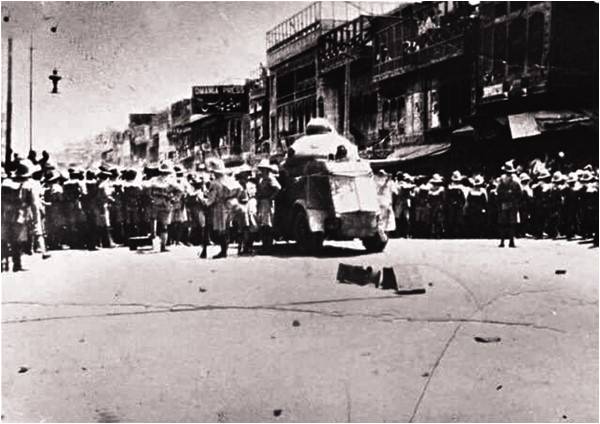
On April 23, 1930 Khudai Khidmatgar protestors led by Moulana Abdur Rahim Popalzai protested against imperialists at Qissa Khwani Bazaar in Peshawar. British troops fired on peaceful protestors, killing 400 people. It became one of the defining moments of the independence movement in British India. It was the first major confrontation between British troops and demonstrators in the city. The gunning down of unarmed people triggered protests across British India and catapulted the newly formed Khudai Khidmatgar movement into prominence.
Olaf Caroe, then secretary to the chief commissioner, gave the following report of the event: ″I received a note on April 23 from Sir Norman Bolton asking me to do what I could to arrange for the burial of as many of the casualties as possible during the night, in order to avoid the danger of a fresh riot occurring over the funeral procession. I spoke to R.S. Mehr Chand Khanna and asked him to bring me some of the leading Khilafists at the Municipal Library. He brought M Abdurrab Nishtar, M Ataullah Jan, Municipal Commissioner; M Aurangzeb Khan, Vakil Qazi Mohd Aslam. I informed these persons what was required and asked for their co-operation as peace-loving citizens and good Muslims. They agreed to do what they could and asked me to arrange for lorries, saying they would persuade the relatives to agree. I arranged for lorries through Shahji – one of C.C.’s orderlies – who is I believe a Peshawari and a Syed. During the night in this way we sent away seven or eight bodies in lorries. Some of them had no relatives and arrangements were made to pay for a mullah and to carry through the obsequies with all regard to religious rites. The next day Qazi Aslam came to see me and said that he was making himself unpopular by assisting in the matter. He gave me to understand that he could do no more. I fancy that the association of these four men with the action taken will put an end to any attempt to make capital of the incident.″
Olaf Caroe, then secretary to the chief commissioner, gave the following report of the event: ″I received a note on April 23 from Sir Norman Bolton asking me to do what I could to arrange for the burial of as many of the casualties as possible during the night, in order to avoid the danger of a fresh riot occurring over the funeral procession. I spoke to R.S. Mehr Chand Khanna and asked him to bring me some of the leading Khilafists at the Municipal Library. He brought M Abdurrab Nishtar, M Ataullah Jan, Municipal Commissioner; M Aurangzeb Khan, Vakil Qazi Mohd Aslam. I informed these persons what was required and asked for their co-operation as peace-loving citizens and good Muslims. They agreed to do what they could and asked me to arrange for lorries, saying they would persuade the relatives to agree. I arranged for lorries through Shahji – one of C.C.’s orderlies – who is I believe a Peshawari and a Syed. During the night in this way we sent away seven or eight bodies in lorries. Some of them had no relatives and arrangements were made to pay for a mullah and to carry through the obsequies with all regard to religious rites. The next day Qazi Aslam came to see me and said that he was making himself unpopular by assisting in the matter. He gave me to understand that he could do no more. I fancy that the association of these four men with the action taken will put an end to any attempt to make capital of the incident.″

